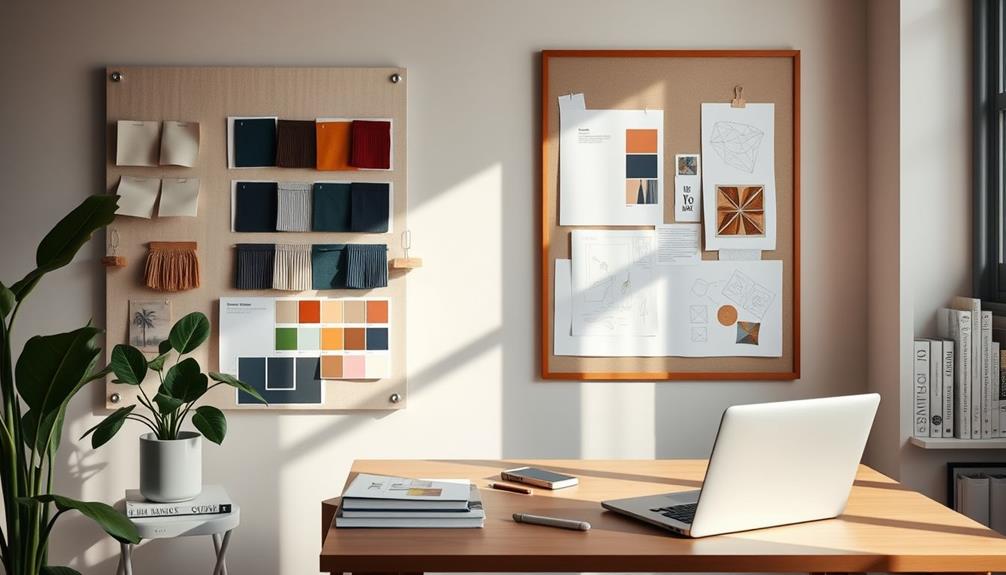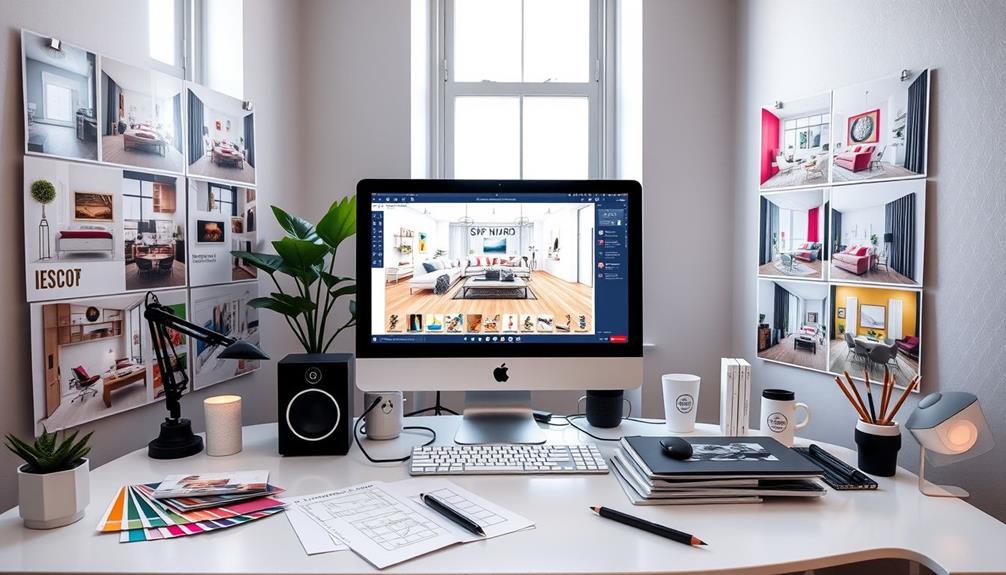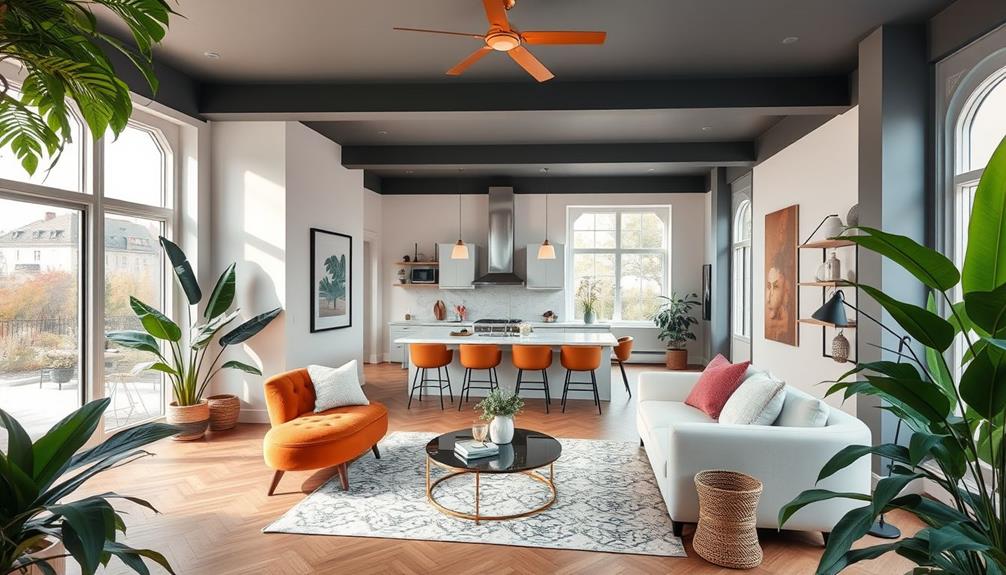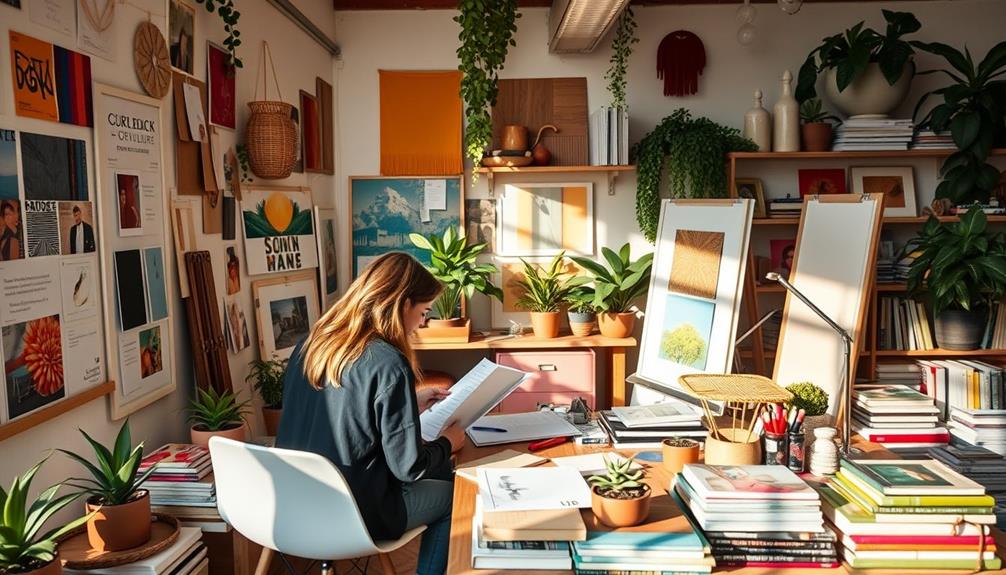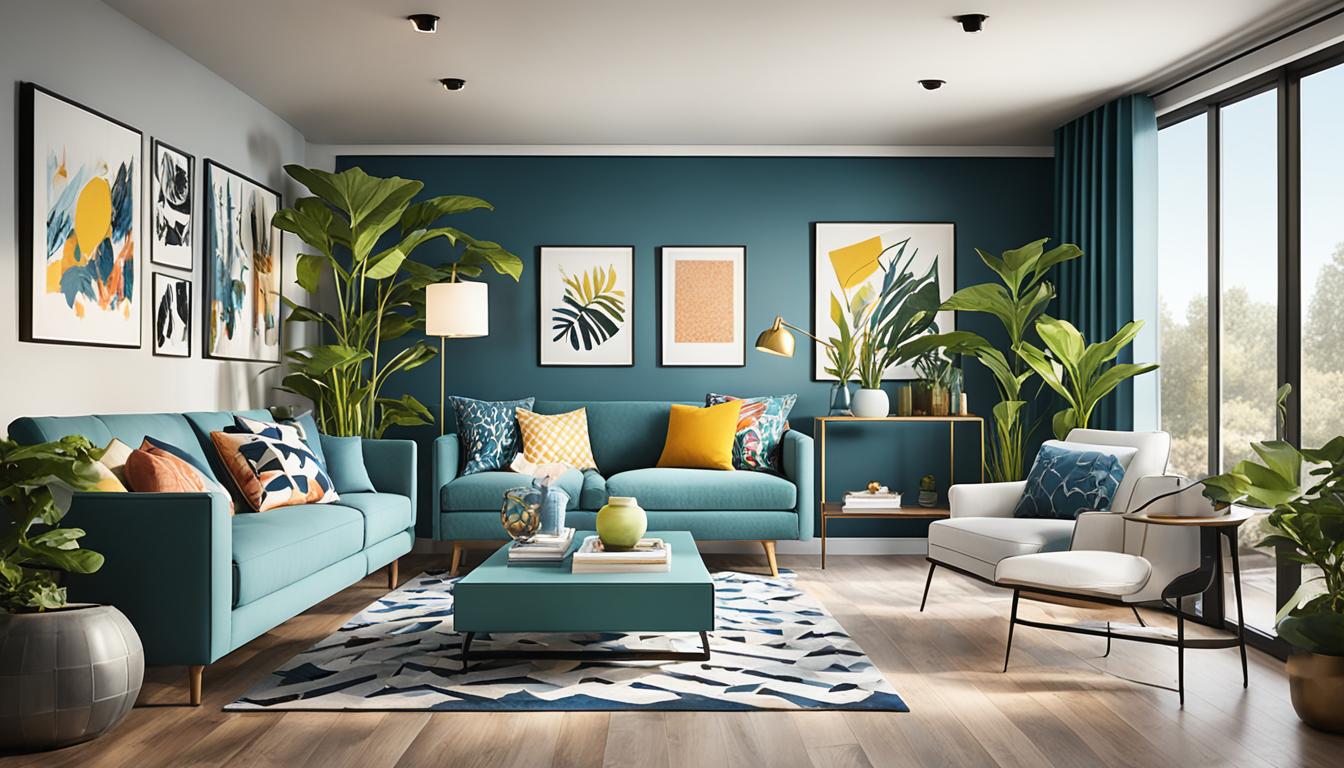To earn your Interior Design Certificate, you should first complete a CIDA-accredited degree program. After that, gain 2-4 years of relevant work experience. With this background, you can register for the NCIDQ exam, which consists of three parts: IDFX, IDPX, and PRAC. Passing all sections is essential for certification and boosts your earning potential. Specialized certifications, like LEED or NKBA, can also enhance your qualifications. As you navigate this journey, you'll find resources and opportunities that can further bolster your career in interior design, revealing even more insights along the way.
Key Takeaways
- Obtain a CIDA-accredited degree to meet the educational requirement for NCIDQ certification.
- Complete 2-4 years of relevant work experience in interior design before exam eligibility.
- Register and pass the NCIDQ Exam, consisting of IDFX, IDPX, and PRAC sections.
- Consider specialized certifications like WELL AP, LEED, or NKBA for niche expertise.
- Engage in continuous education and practical experiences to enhance skills and marketability.
Understanding Interior Design Certification
When you pursue an interior design certification, you're taking a considerable step toward validating your expertise in a field that prioritizes public health, safety, and welfare. Among the most recognized is the NCIDQ certification, which demonstrates your knowledge of essential codes and standards.
To obtain this certification, you need a CIDA-accredited degree and 2-4 years of relevant work experience. After that, you'll face three exams: IDFX, IDPX, and PRAC.
Specialized certifications like WELL Accredited Professional (WELL AP) focus on health in built environments, while Leadership in Energy and Environmental Design (LEED) emphasizes sustainable practices.
These certifications not only enhance your professional recognition but can also considerably boost your career opportunities and earning potential. In fact, NCIDQ certified designers typically earn around $16,000 more annually than those without certification.
Continuous education and acquiring additional certifications can further sharpen your skills and improve your marketability in the competitive interior design industry.
Importance of NCIDQ Certification

The NCIDQ Certification serves as an important credential that validates your expertise in critical public health, safety, and welfare codes in interior design. This certification isn't just a badge; it's often required for interior design licensure in most U.S. and Canadian jurisdictions, except California.
By obtaining the NCIDQ certification, you join a select group of certified interior designers recognized by state and provincial regulators, which greatly boosts your credibility in the field.
Moreover, NCIDQ certified designers tend to earn, on average, $16,000 more annually compared to their uncertified counterparts. This financial incentive highlights the value of certification not just for knowledge, but also for enhancing your earning potential.
Beyond financial benefits, achieving this certification instills confidence in clients and employers, elevating your visibility and recognition within the professional interior design community. It positions you as a knowledgeable practitioner committed to adhering to industry standards.
If you aspire to advance your career and make a mark in interior design practice, pursuing NCIDQ Certification is an essential step to guarantee you stand out in a competitive landscape.
NCIDQ Exam Structure

Understanding the NCIDQ Exam structure is vital for your certification journey.
You'll need to familiarize yourself with the three sections: IDFX, IDPX, and PRAC, each testing different skills essential for interior design.
Additionally, make sure you meet the eligibility requirements set by the Council for Interior Design Qualification before you can register.
Exam Sections Overview
To earn your NCIDQ certification, you need to navigate through three distinct sections of the exam: IDFX, IDPX, and PRAC. Each section is vital for demonstrating your knowledge and competency in interior design, focusing on public health, safety, and welfare.
- IDFX (Fundamentals): This section consists of 125 questions that assess your foundational knowledge of interior design principles.
- IDPX (Professional): With 175 questions, this section tests your ability to apply that knowledge in practical scenarios.
- PRAC (Practicum): In this practical exam, you'll answer 114 questions based on real-world projects, showcasing your problem-solving skills.
You must pass all three sections within a specified timeframe to obtain your NCIDQ certification, which state and provincial regulators recognize.
Remember, the NCIDQ Exam is offered biannually in April and October, and you'll need to pay fees of $295 for IDFX, $355 for IDPX, and $460 for PRAC.
Before you can take the exam, confirm you meet the eligibility requirements laid out by the Council for Interior Design Qualification (CIDQ), including having a CIDA accredited degree and relevant work experience.
Eligibility Requirements Explained
Achieving eligibility for the NCIDQ Exam hinges on a few key requirements. First, you'll need a degree from a CIDA-accredited program, which guarantees your education meets industry standards.
Depending on your educational background, you'll then need 2 to 4 years of relevant work experience. This hands-on experience is vital for preparing you to tackle real-world design challenges.
Before you can schedule the exam, you must receive approval from the Council for Interior Design Qualification (CIDQ). This step is significant, as it confirms you meet the eligibility requirements to proceed.
Once approved, you can register for any of the three exam sections: IDFX, IDPX, and PRAC.
Each section of the NCIDQ Exam tests different skills. The IDFX focuses on fundamental design knowledge, while the IDPX assesses your professional skills.
Finally, the PRAC evaluates your practical application abilities. To become a certified interior designer, you must pass all sections within a specified timeframe.
Keep in mind that exam fees vary: $295 for IDFX, $355 for IDPX, and $460 for the Practicum. Make certain you're prepared and ready to take on this important step in your interior design career!
Core Competencies Assessed

The NCIDQ Exam evaluates five core competencies essential for aspiring interior designers.
These competencies guarantee you have a thorough understanding of interior design principles and practices needed to succeed in the field.
Here's what you'll be assessed on:
- Building Systems: You must grasp how structural elements integrate into design projects, guaranteeing functionality and aesthetics.
- Construction Standards: Knowledge of relevant codes is vital, as it underscores the importance of public health, safety, and welfare in your designs.
- Professional Practice: Skills in contract administration and project coordination are evaluated, highlighting the need for effective management of design contracts and client relationships.
Specialized Design Certifications

While mastering core competencies is essential for a successful career in interior design, pursuing specialized design certifications can further distinguish you in the industry. Certifications like those from the National Kitchen and Bath Association (NKBA) can enhance your expertise in kitchen and bath design. By obtaining the Associate Kitchen & Bath Designer (AKBD) or Certified Kitchen and Bath Designer credentials, you'll show potential clients your commitment and knowledge in this niche area.
If you're interested in healthcare design, the American Academy of Healthcare Interior Designers (AAHID) offers the CHID credential, which signifies your proficiency in healthcare settings. This certification requires a combination of experience and education, emphasizing your specialized skill set.
Additionally, becoming a Certified Aging-in-Place Specialist (CAPS) can set you apart by focusing on accessibility and safety for aging populations. Completing specific coursework and passing an exam will equip you with crucial knowledge about health and wellness in design.
These specialized certifications not only enhance your professional recognition but also lead to increased earning potential and client acquisition in niche markets. Pursuing them can elevate your career and broaden your opportunities within the interior design field.
Educational Pathways and Programs

When you're considering a career in interior design, it's important to understand the degree requirements and certification options available to you.
You can explore various online learning opportunities that fit your schedule and learning style.
This foundation will help you navigate the educational pathways that lead to a successful career in the field.
Degree Requirements Overview
Earning an interior design certificate typically involves completing an accredited program that blends technical skills, creative thinking, and business knowledge. Many programs offer an Associate of Applied Science (AAS) degree or specialized certificate courses focused on essential design principles and practices. These programs often cover topics such as space planning, color theory, furniture design, and project management. Graduates with an interior design certificate are well-equipped to pursue careers in residential or commercial design, and the credentials earned can help attract new clients for your interior design business. In addition to providing the skills and knowledge needed to thrive in the industry, an interior design certificate can also demonstrate a commitment to professionalism and excellence in the field.
You'll likely engage in hands-on projects that enhance your portfolio development, showcasing your skills and understanding of current industry trends.
Here are some key components you can expect in your coursework:
- Programming and Planning: Learn to assess client needs and plan effective interior spaces.
- Professional Design Communication: Develop skills to engage with clients and adhere to industry standards, essential for the Interior Design Qualification (CIDQ).
- Portfolio Development: Curate a collection of your best work, demonstrating your design capabilities to future employers.
While some programs may require prerequisites, many do not, making it more accessible for aspiring designers.
Certification Programs Available
After completing your degree requirements, you can explore various certification programs that enhance your credentials and showcase your expertise in interior design. These certification programs available can help you stand out in a competitive field. Here are some notable options:
| Certification Program | Requirements |
|---|---|
| NCIDQ Exam | CIDA-accredited degree; 2-4 years experience |
| Certified Interior Decorators International | Varies by preparation; exam fees vary |
| National Kitchen and Bath Association (NKBA) | Associate Kitchen & Bath Designer credentials |
| American Academy of Healthcare Interior Designers | CHID requires 3 years experience; $400 exam fee |
| Leadership in Energy and Environmental Design | LEED Green Associate; $250 exam fee |
Pursuing the NCIDQ Exam is essential for many, as it's a standard for professional qualification. If you're interested in kitchens and baths, the NKBA offers specialized certifications. For those focusing on healthcare design, the AAHID provides recognition through the CHID credential. Finally, if you're passionate about sustainability, consider the LEED certification to promote eco-friendly practices. Each path offers unique opportunities to elevate your career.
Online Learning Opportunities
Online learning opportunities for interior design certificates offer a flexible and accessible way to gain essential skills in the field. With online learning programs, you can study at your own pace, fitting your education around your busy lifestyle.
These programs often cover vital topics, preparing you to tackle real-world challenges in interior design.
Consider these benefits when exploring online options:
- Accredited Certifications: Many programs lead to accredited certifications, enhancing your professional credibility and making you more marketable.
- Hands-On Projects: You'll have opportunities for portfolio development through hands-on projects, allowing you to showcase your skills to potential employers.
- Certification Exam Prep: Most programs prepare you for essential certification exams, such as the Residential Interior Designer Exam (RIDE), ensuring you're ready to demonstrate your knowledge and skills.
Gaining Practical Experience

Gaining practical experience in interior design is essential for building your skills and enhancing your resume. To meet the requirements for the NCIDQ Exam, you'll typically need 2-4 years of work experience. Internships or entry-level positions are great ways to start.
Many interior design programs include hands-on projects that foster portfolio development, allowing you to apply what you've learned in real-world settings.
Networking is vital in this field. Engaging with professionals through student organizations or internships can open doors to valuable insights and opportunities.
Additionally, consider participating in design competitions or volunteering for community projects. These activities not only enhance your practical skills but also help create a diverse portfolio that showcases your design capabilities.
Don't overlook the benefits of mentorship programs. Partnering with experienced interior designers can provide guidance and real-world experience, bridging the gap between your education and professional practice.
Career Opportunities in Interior Design

The landscape of career opportunities in interior design is both dynamic and promising, offering a variety of paths for aspiring professionals. With an expected job growth rate of 2.0% in the Greater Houston area alone, there are about 75 annual job openings for interior designers.
Interior designers must consider obtaining certifications to enhance their job prospects and earning potential.
Here are three key areas to focus on:
- NCIDQ Certified interior designers: This certification can greatly boost your credibility and marketability in the industry.
- Specialization: Gaining certifications in areas like kitchen and bath design or aging-in-place can set you apart from the competition.
- Continuous skill development: Staying updated with the latest trends and technologies will improve your career advancement opportunities.
In the U.S., the median wage for interior designers is around $27.57 per hour, translating to about $57,000 annually.
As demand for skilled professionals increases by 5% through 2026, the potential for growth is evident. By focusing on certifications and continuous improvement, you can position yourself for a successful career in interior design.
Conclusion
In your journey toward an interior design certificate, you're not just ticking boxes; you're crafting a vibrant canvas for your future. Embrace the learning and experiences that come your way, as each step adds a splash of color to your professional palette. With dedication and creativity, you'll open doors to exciting career opportunities, transforming spaces and lives. So, immerse yourself and let your passion for design illuminate your path—your bright future in interior design awaits!
